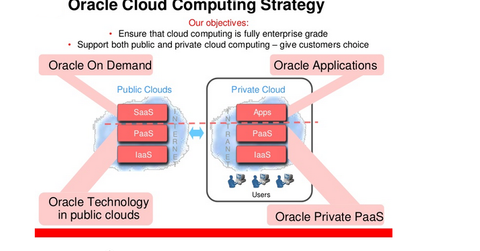Oracle’s Cloud Strategy Is Different from Its Peers
Oracle’s strategy of transitioning to cloud seems to be yielding results. The revenue from overall software continues to dominate its top-line revenue.
April 3 2015, Updated 7:06 p.m. ET

Oracle’s cloud strategy
In 4Q14, Oracle (ORCL) declared its three-pronged cloud services strategy. It listed revenue separately from three cloud offerings:
- SaaS (software-as-a-service)
- PaaS (platform-as-a-service)
- IaaS (infrastructure-as-a-service)
It hosts its suite of applications as software on demand. Its database and middleware tools are available as a platform on demand. Recently, it included engineered computing systems as infrastructure on demand.
To gain diversified exposure to Oracle, you can invest in the iShares US Technology ETF (IYW). IYW invests about 3.92% of its holdings in Oracle.
As the above chart shows, Oracle seems to be on its way to finding a balance between enabling technology and packaged cloud. Microsoft (MSFT), IBM (IBM), VMWare, and HP (HPQ) are some other players that are also striving to find a similar balance.
Apart from strategic acquisitions, IBM partnered with its peers to expand its reach in the cloud and enterprise mobility space. HP announced a $1 billion dollar investment to develop cloud-computing software and tools over a two-year period. It also acquired Eucalyptus—a provider of open source software for building private and hybrid enterprise clouds.
Oracle offers maximum cloud offerings under one umbrella
Although global cloud application vendors host their software on demand as a platform, their applications are usually specialized or focused towards a particular business requirement—like sales, CRM (customer relationship management), or human resources.
In contrast, Oracle’s Cloud SaaS offering has a wider reach. It covers sales, marketing, customer service, financials, project management, human capital, and talent management solutions. Oracle’s HCM (human capital management) software helps companies manage employees, benefits, and recruitment.
Software and cloud dominate the top-line revenue
The company’s strategy of transitioning to cloud seems to be yielding results. The revenue from overall software continues to dominate Oracle’s top-line revenue. Software and cloud licenses’ overall contribution to top-line revenue has been increasing consistently from 72% in 2012 to 76.6% in the nine months ending 2015.
